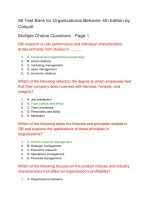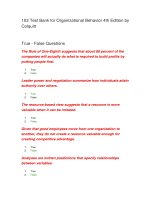Organizational behavior 4th by MShean chap014
Bạn đang xem bản rút gọn của tài liệu. Xem và tải ngay bản đầy đủ của tài liệu tại đây (375.45 KB, 26 trang )
14
Leadership in
Organizational Settings
McGraw-Hill/Irwin
© 2008 The McGraw-Hill Companies, Inc. All rights reserved.
Leadership at Infosys
“In essence, leadership is
about dreaming the impossible
and helping followers achieve
the same,” says Nandan
Nilekani, chief executive of
Infosys, one of India’s largest
and most successful
information technology
companies.
McShane/Von Glinow OB4e
Slide 14-2
© 2008 The McGraw-Hill Companies, Inc. All rights reserved.
What is Leadership?
Leadership is the ability to
influence, motivate, and
enable others to contribute
toward the effectiveness of the
organizations of which they
are members.
McShane/Von Glinow OB4e
Slide 14-3
© 2008 The McGraw-Hill Companies, Inc. All rights reserved.
Shared Leadership
• Leadership is not restricted to people in formal
management positions.
• Anyone in the organization may -- and should -- be a
leader in various ways and at various times.
• Effective companies encourage employees to be
leaders when needed (e.g. change champions)
McShane/Von Glinow OB4e
Slide 14-4
© 2008 The McGraw-Hill Companies, Inc. All rights reserved.
Perspectives of Leadership
Competency
Perspective
Implicit
Leadership
Perspective
Leadership
Perspectives
Transformational
Perspective
McShane/Von Glinow OB4e
Behavioral
Perspective
Contingency
Perspective
Slide 14-5
© 2008 The McGraw-Hill Companies, Inc. All rights reserved.
Seven Leadership Competencies
Emotional
Intelligence
Integrity
Drive
Leadership
Motivation
• Perceiving, assimilating, understanding,
and regulating emotions
• Truthfulness
• Translates words into deeds
• Inner motivation to pursue goals
• Need for achievement, quest to learn
• High need for socialized power to
accomplish team’s or firm’s goals
more
McShane/Von Glinow OB4e
Slide 14-6
© 2008 The McGraw-Hill Companies, Inc. All rights reserved.
Seven Leadership Competencies (con’t)
Self-Confidence
• Strong belief in one’s ability to lead
others
Intelligence
• Above average cognitive ability
• Can analyze problems/opportunities
Knowledge of
the Business
• Familiar with business environment
• Aids intuitive decision making
McShane/Von Glinow OB4e
Slide 14-7
© 2008 The McGraw-Hill Companies, Inc. All rights reserved.
In Search of Leader Integrity
• Likely the most important leadership competency
• Also called “authentic leadership”
– Individual acts with sincerity
– Has a higher moral capacity to judge dilemmas
• Most people think business leaders lack integrity:
– 73% say CEOs of large firms can’t be trusted (US)
– Less than one-third of Asian workers are satisfied with their
level of trust in management
McShane/Von Glinow OB4e
Slide 14-8
© 2008 The McGraw-Hill Companies, Inc. All rights reserved.
Competency Perspective Limitations
• Implies a universal approach
• Alternative combinations of competencies might work just
as well
• Some traits are subjective
• Several competencies indicate leadership potential, not
actual leadership
McShane/Von Glinow OB4e
Slide 14-9
© 2008 The McGraw-Hill Companies, Inc. All rights reserved.
Leader Behavior Perspective
What makes Bruce Draper (shown here) one of the best bosses
in Great Britain? He provides plenty of supportive leadership,
says employee Hannah Delany. “Bruce cares about his staff
and never takes them for granted…He appears friendly,
approachable and kind and makes sure everyone is content in
their job.”
McShane/Von Glinow OB4e
Slide 14-10
© 2008 The McGraw-Hill Companies, Inc. All rights reserved.
Leader Behavior Perspective
• People-oriented behaviors
– Showing mutual trust and respect
– Concern for employee needs
– Looks out for employee well-being
• Task-oriented behaviors
– Assign specific tasks
– Ensure employees follow rules
– Set “stretch goals” to achieve performance capacity
McShane/Von Glinow OB4e
Slide 14-11
© 2008 The McGraw-Hill Companies, Inc. All rights reserved.
Path-Goal Leadership Styles
• Directive
– Task-oriented behaviors
• Supportive
– People-oriented behaviors
• Participative
– Encouraging employee involvement
• Achievement-oriented
– Using goal setting and positive selffulfilling prophecy
McShane/Von Glinow OB4e
Slide 14-12
© 2008 The McGraw-Hill Companies, Inc. All rights reserved.
Path-Goal Leadership Model
Employee
Contingencies
Leader
Behaviors
•
•
•
•
Leader
Effectiveness
• Employee
motivation
• Employee
satisfaction
• Leader
acceptance
Directive
Supportive
Participative
Achievementoriented
Environmental
Contingencies
McShane/Von Glinow OB4e
Slide 14-13
© 2008 The McGraw-Hill Companies, Inc. All rights reserved.
Path-Goal Contingencies
Employee
Contingencies
• Skill/Experience
• Locus of Control
Environmental
Contingencies
Directive Supportive Participative Achievement
low
low
high
high
external
external
internal
internal
Directive Supportive Participative Achievement
Task Structure
nonroutine
routine
nonroutine
?
Team Dynamics
–ve norms
low cohesion
+ve norms
?
McShane/Von Glinow OB4e
Slide 14-14
© 2008 The McGraw-Hill Companies, Inc. All rights reserved.
Other Contingency Leader Theories
• Situational Leadership Model (Hersey/Blanchard)
– Effective leaders vary style with follower “readiness”
– Leader styles – telling, selling, participating, and delegating
– Theory lacks research support
• Fiedler’s Contingency Model
– Leadership style is stable --based on personality
– Best style depends on situational control
– Theory has problems, but uniquely suggests that people have a
preferred leadership style based on personality
McShane/Von Glinow OB4e
Slide 14-15
© 2008 The McGraw-Hill Companies, Inc. All rights reserved.
Leadership Substitutes
• Contingencies that limit a leader’s influence or make a
particular leadership style unnecessary.
• Examples:
–Training and experience replace task-oriented leadership
–Cohesive team replaces supportive leadership
–Self-leadership replaces achievement-oriented leadership
• Research evidence: substitutes help, but don’t
completely substitute for real leadership
McShane/Von Glinow OB4e
Slide 14-16
© 2008 The McGraw-Hill Companies, Inc. All rights reserved.
Transformational Leadership at P&G
Procter & Gamble CEO A. G.
Lafley practices transformational
leadership without using charisma.
By forming and communicating a
clear vision and modeling that
vision, he has transformed the
consumer goods company in
recent years.
McShane/Von Glinow OB4e
Slide 14-17
© 2008 The McGraw-Hill Companies, Inc. All rights reserved.
Transformational v. Transactional Leaders
• Transformational leaders
– Leading -- changing the
organization to fit environment
– Change agents
• Transactional leaders
– Managing -- linking job
performance to rewards
– Ensure employees have
necessary resources
– Apply contingency leadership
McShane/Von Glinow OB4e
Slide 14-18
© 2008 The McGraw-Hill Companies, Inc. All rights reserved.
Transformational v. Charismatic Leaders
• Is charismatic leadership essential
for transformational leadership?
• Some experts say yes, but
emerging view is that:
– Charisma is distinct from
transformational leadership
– A personal trait that might help
transform, or might just help the
leader
– Charismatic leadership might have
opposite effect -- creates
dependence, not empowerment
McShane/Von Glinow OB4e
Slide 14-19
© 2008 The McGraw-Hill Companies, Inc. All rights reserved.
Transformational Leadership Elements
Creating
a Strategic
Vision
Communicating
the Vision
Transformational
Leadership
Building
Commitment
McShane/Von Glinow OB4e
Modeling
the Vision
Slide 14-20
© 2008 The McGraw-Hill Companies, Inc. All rights reserved.
Evaluating Transformational Leadership
• Transformational leadership is important
– Higher employee satisfaction, performance, org
citizenship, creativity
• Transformational leadership limitations
– Circular logic -- leaders effective by definition
– Universal theory
• Need a contingency-oriented theory
• Recognize differences across cultures
McShane/Von Glinow OB4e
Slide 14-21
© 2008 The McGraw-Hill Companies, Inc. All rights reserved.
Implicit Leadership Perspective
Attributing
Leadership
Implicit
Leadership
Perspective
Need for
Situational
Control
McShane/Von Glinow OB4e
Stereotyping
Leadership
Slide 14-22
© 2008 The McGraw-Hill Companies, Inc. All rights reserved.
Cultural Issues in Leadership
• Societal cultural values and practices affect leaders:
– Shape leader’s values/norms
– Influence decisions and actions
• Some leadership styles are universal, others differ
across cultures
– “Charismatic visionary” seems to be universal
– Participative leadership works better in some cultures
than others
McShane/Von Glinow OB4e
Slide 14-23
© 2008 The McGraw-Hill Companies, Inc. All rights reserved.
Gender Issues in Leadership
• Male and female leaders have
similar task- and people-oriented
leadership.
• Participative leadership style is
used more often by female leaders.
McShane/Von Glinow OB4e
Slide 14-24
© 2008 The McGraw-Hill Companies, Inc. All rights reserved.
Evaluating Female Leaders
• Past evidence
– Women rated less favorably than equivalent male
leaders due to stereotyping
• Recent evidence
– Women rated more favorably than men, particularly
on emerging leadership styles (coaching,
teamwork)
McShane/Von Glinow OB4e
Slide 14-25
© 2008 The McGraw-Hill Companies, Inc. All rights reserved.









